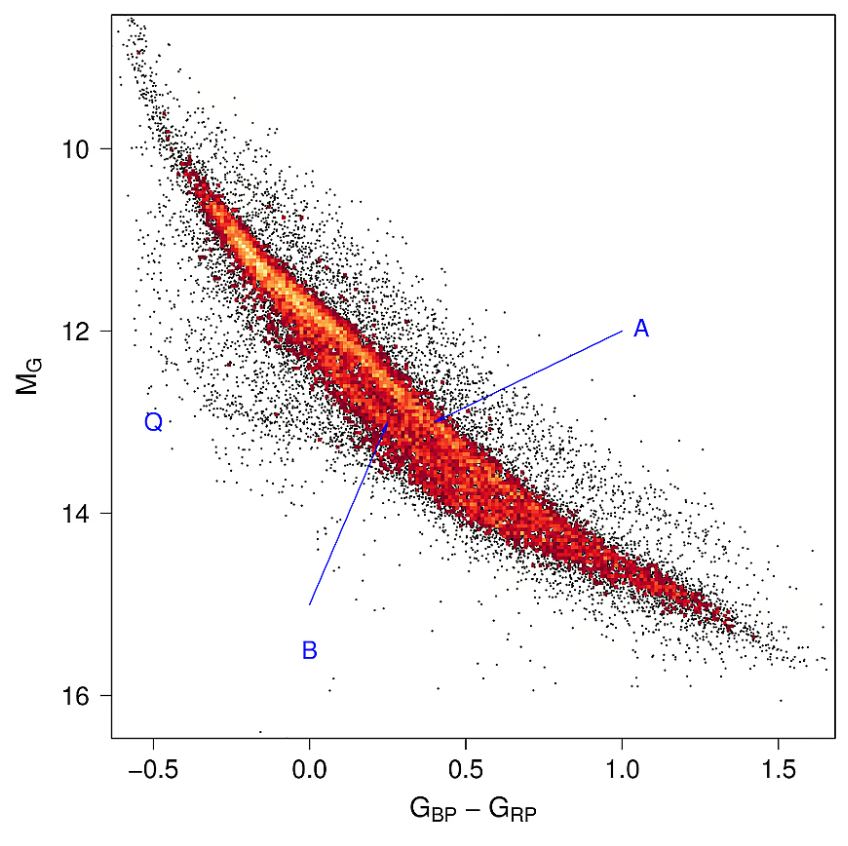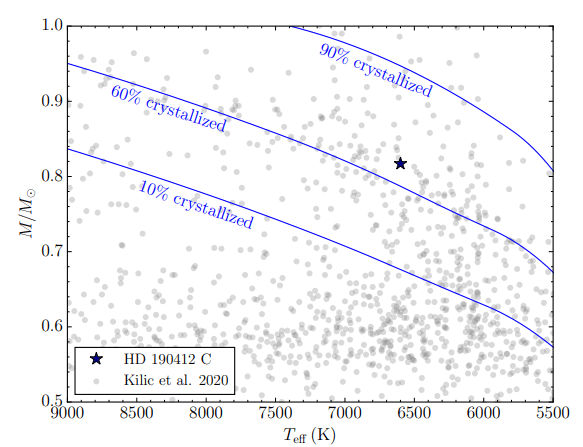White dwarfs are the stellar remnants of stars like our Sun. They’re strange objects, and astrophysicists think their cores can crystallize into enormous diamonds. But they need to find more of these strange objects, and they need to know their ages, to understand how and when it happens.
When stars with similar masses as our Sun run out of hydrogen, fusion ceases. At that point, they leave the main sequence and become red giants. Chaos ensues as the star’s loss of mass weakens its self-gravity. It can’t hold onto itself, and the outer layers are shed into space, creating the beautiful planetary nebulae we’ve all seen in telescope images. These nebulae don’t last long, maybe 10,000 years.
But that’s not the end of the star. What’s left of the star is a white dwarf, a stellar remnant core as large as Earth and as massive as the Sun. White dwarfs are dense globs of mostly electron-degenerate matter that last for quadrillions of years. Even though white dwarfs have left their life of fusion behind, they still radiate enough thermal energy to light up the gaseous shells they shed, powering the gorgeous nebulae they leave behind.
 The James Webb Space Telescope captured this image of the Southern Ring Nebula, or NGC 3132, with its NIRCAM instrument. A white dwarf star is clearly visible in the center of the planetary nebula. Image Credit: By Image: NASA/CSA/ESA/STScI
The James Webb Space Telescope captured this image of the Southern Ring Nebula, or NGC 3132, with its NIRCAM instrument. A white dwarf star is clearly visible in the center of the planetary nebula. Image Credit: By Image: NASA/CSA/ESA/STScIA white dwarf can last 100 quintillion years, according to theory. They take a long time to cool off, and at some point in that cooling process, they can form gigantic crystals in their cores. Astrophysicists know what the observational signature is for the crystallization, but something in the timing doesn’t match up.
A white dwarf’s core is initially a liquid. Over time the star ages and cools, and the liquid crystallizes, becoming a solid. When that happens, there’s an increase in the heat the star releases. That heat is a signature, and it predicted distinct sequences white dwarfs go through on the Hertzsprung-Russell Diagram. That’s all good as a theory, but there’s a lack of precise temperature and age measurements for white dwarfs. That prevented astronomers from detecting the crystallization phenomenon.
 The Hertzsprung-Russel Diagram (HR Diagram) plots stars by temperature and brightness. Image Credit: European Southern Observatory
The Hertzsprung-Russel Diagram (HR Diagram) plots stars by temperature and brightness. Image Credit: European Southern ObservatoryThe HR Diagram shows a star’s luminosity versus its temperature. In 2018, the ESA’s Gaia spacecraft released its second dataset, and it added more detail to the white dwarf section of the HR Diagram. Gaia has a powerful ability to provide precise parallax measurements for white dwarfs, something that’s been historically difficult to obtain. The new data showed three different evolutionary tracks for white dwarfs. Two of them were parallel, and are well understood. But the third one was new and didn’t follow any evolutionary path for known white dwarfs.
It was an “Ah-hah!” moment.
 This image from the ESA’s Gaia 2nd data release shows three evolutionary tracks for white dwarfs. A and B are well-known, but Q was new. Image Credit: Gaia DR2 – Observational Hertzsprung-Russell diagrams.
This image from the ESA’s Gaia 2nd data release shows three evolutionary tracks for white dwarfs. A and B are well-known, but Q was new. Image Credit: Gaia DR2 – Observational Hertzsprung-Russell diagrams.Tracks A and B represent white dwarfs cooling at a constant rate, a predictable observation for white dwarfs that sets them apart from other stars. But Q shows the release of heat as white dwarfs crystallize, raising their temperature and slowing their cooling.
But Gaia’s data is based not on a single, observable star. It’s more like mass data. Gaia’s second data release was based on over one billion light sources. After it was released, a research team extracted 260,000 likely white dwarfs from the entire dataset. That represented an order-of-magnitude increase in the number of known white dwarfs, and it allowed that team to characterize the crystallization process.
But there’s still a lack of data on the timing of the crystallization. Now a separate group of researchers are seeking more clarity, and they’ve found exactly what they need to get that clarity: a white dwarf in the process of crystallizing. Not only is it crystallizing, but they’re able to determine its age.
They’re publishing a new paper in the Monthly Notices of the Royal Astronomical Society titled “A Crystallizing White Dwarf in a Sirius-Like Quadruple System.” The lead author is Alexander Venner, a Ph.D. student in the Center for Astrophysics at the University of Southern Queensland. The paper is on the pre-print server arxiv.org.
 This image of the ring nebula, also called M57, shows the intricate filaments and blobs of gas and dust that surround the white dwarf in the center. Image Credit: By Göran Nilsson & The Liverpool Telescope – Own work, CC BY-SA 4.0, https://commons.wikimedia.org/w/index.php curid=63295181
This image of the ring nebula, also called M57, shows the intricate filaments and blobs of gas and dust that surround the white dwarf in the center. Image Credit: By Göran Nilsson & The Liverpool Telescope – Own work, CC BY-SA 4.0, https://commons.wikimedia.org/w/index.php curid=63295181The critical part of this work is that the white dwarf is in a system with other main-sequence stars. It’s easier to find the ages of those stars than it is for white dwarfs, so by extension, they can more accurately date the white dwarf and the age at which it crystallizes.
“In this work, we report that a recently discovered white dwarf is a bound companion to the triple star HD 190412, forming a new Sirius-like system in the solar neighbourhood,” the authors write in their paper. “The location of HD 190412 C on the Teff—mass diagram implies it is undergoing crystallization, making this the first confirmed crystallizing white dwarf whose total age can be externally constrained.”
The white dwarf is about 104 light-years away and is made of mostly metallic oxygen. It has three stellar companions and is similar to another nearby white dwarf, Sirius B. The researchers are focused on measuring the star’s cooling and the delay caused by the crystallization.
“Motivated by the possibility that a cooling delay caused by crystallization can be directly detected for this white dwarf, we employ a variety of methods to constrain the age of the system,” the team writes.
 This figure from the research shows the mass and effective temperature of HD 190412 C and of white dwarfs in a separate statistical sample (circles). The authors say there is a clear “pile-up” of white dwarfs along the 60% crystallized line. Previous research says this represents a cooling delay caused by 22Ne phase separation. “As HD 190412 C lies within this overdensity in the Teff—mass plane,” the researchers explain, “it is an important benchmark for understanding this feature of the white dwarf population.” Image Credit: Venner et al. 2023
This figure from the research shows the mass and effective temperature of HD 190412 C and of white dwarfs in a separate statistical sample (circles). The authors say there is a clear “pile-up” of white dwarfs along the 60% crystallized line. Previous research says this represents a cooling delay caused by 22Ne phase separation. “As HD 190412 C lies within this overdensity in the Teff—mass plane,” the researchers explain, “it is an important benchmark for understanding this feature of the white dwarf population.” Image Credit: Venner et al. 2023Despite what it might seem like, it’s difficult to determine the ages of main sequence stars to a high degree of accuracy. Astronomers use several methods to try to constrain their ages. One is isochronal fit, where astronomers observe a star’s temperature and luminosity and compare it with model isochrones. (Isochrones are sets of physical parameters like metallicity and mass.)
The second is through stellar kinematics. Tracking the motion of a star through its galaxy can give some information about age because older stars usually move faster, whereas younger stars tend to move more slowly.
Astronomers also use chemical abundance to determine a star’s age. A star’s magnetic field can also provide clues to its age, at least for some types of stars. Sun-like stars can experience a reduction in magnetic field strength over time.
None of these methods is perfect, and each one arrives at a different age. But they can be used in combination to come up with close approximations of an individual star’s age. Since the white dwarf is in association with three main sequence stars, the white dwarf’s age can be constrained, if not fully revealed.
“The association of HD 190412 C with the main sequence stars HD 190412 AB makes this the first identified crystallizing white dwarf whose total age can be externally constrained,” the authors write. “… it is possible, in principle, to empirically detect a delay in its cooling by comparing the model age of the white dwarf against the age of the system.”
According to their work, the age is 7.3 (+1.9 / -1.8) billion years.
But there are some caveats with that number. While the ages of all four stars are compatible, the researchers say that their results suggest the white dwarf’s age is an underestimation, if anything.
The researchers’ goal was to test white dwarf cooling models and to determine when crystallization takes place. The idea is to detect the age at which the white dwarf experiences a cooling anomaly as the core crystallizes. Unfortunately, their age estimate is too imprecise to nail it down completely, though they hope future efforts to determine the white dwarf’s age will be more precise.
Though the age may be imprecise, there’s far less uncertainty about its crystallization. The researchers determined the star’s mass and temperature, “… a combination which places it firmly in the parameter space predicted to be occupied by white dwarfs undergoing core crystallization.” That makes it the first confirmed crystallizing white dwarf in a Sirius-like system. Its location in a Sirius-like system is critical because that’s what makes its age open to investigation.
 Not all white dwarfs face a future of crystallization. Many are in association with other stars. A Type Ia supernova occurs when a white dwarf accretes material from a companion star until it exceeds the Chandrasekhar limit and explodes. Image Credit: NASA/CXC/M. Weiss
Not all white dwarfs face a future of crystallization. Many are in association with other stars. A Type Ia supernova occurs when a white dwarf accretes material from a companion star until it exceeds the Chandrasekhar limit and explodes. Image Credit: NASA/CXC/M. WeissThe system is only 32 parsecs away, and the researchers think it’s likely that there’ll be more of these types of systems. Their work is helping to open a new avenue in studying white dwarf crystallization. Systems like this one with both a white dwarf and main sequence stars are likely numerous, which will make white dwarf crystallization easier to study. “Future discoveries may therefore allow for stronger tests of white dwarf crystallization models,” they write.
White dwarfs are truly strange objects. After a lifetime of billions of years of fusion, they transform themselves into something else completely different. They transition from blazing balls of plasma to degenerate lumps of carbon that eventually crystallize into diamonds that last for unimaginably long time periods.
It takes a quadrillion years for a white dwarf to crystallize, and since the Universe is not even 14 billion years old, astronomers will never spot a fully crystallized one. But this research removes some of the mystery by finding one that’s just starting to become a cosmic diamond. Curious astronomers will study more of these bizarre stellar remnants, and one day, we may know exactly how and when something so strange can happen.

